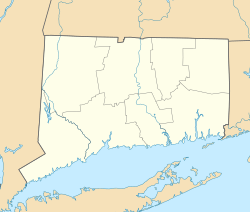Elm Street Historic District (Rocky Hill, Connecticut) facts for kids
Quick facts for kids |
|
|
Elm Street Historic District
|
|
| Location | Along Elm St., from 18 to 191 Elm St., Rocky Hill, Connecticut |
|---|---|
| Area | 20 acres (8.1 ha) |
| Architectural style | Colonial, Greek Revival, Italianate |
| NRHP reference No. | 98000358 |
| Added to NRHP | April 13, 1998 |
The Elm Street Historic District is a special area in Rocky Hill, Connecticut. It shows off an old road from colonial times and many different styles of houses. Elm Street, between Silas Deane Highway and Grimes Road, was first built in the late 1600s. It's unique because it's still super wide, just like roads used to be back then! The homes along this street were built between 1769 and the 1930s. This historic district was added to the National Register of Historic Places in 1998.
Contents
What is the Elm Street Historic District?
Elm Street in Rocky Hill was created in the late 1600s. It was an important road leading west from the Rocky Hill–Glastonbury ferry. This ferry started running in 1655. It is thought to be the oldest ferry in the United States that has been running without stopping!
How wide is Elm Street?
When the road was first made, it was about 20 rods wide. That's about 300 feet (91 m)! Most old roads like this became narrower over time. But this part of Elm Street kept its original width. You can see two rows of trees on one side and one row on the other. They fill up the wide space of the road.
Oldest Buildings on Elm Street
The oldest buildings still standing on Elm Street date back to 1769. These very old homes are found near where Chapin and Ashwell Streets meet Elm Street.
What Kinds of Houses Are There?
The Elm Street Historic District has 35 homes. Almost all of them are made of wood. They are usually 1-1/2 to 2-1/2 stories tall. There is one house made of brick at 43 Elm Street, but it's not considered historically important.
When Were Most Houses Built?
Most of the houses in this district were built in the early 1900s. You can see many different styles of architecture.
Popular House Styles
The most common style is Colonial Revival. This style brings back ideas from colonial times. Other popular styles include American Foursquare, Tudor Revival, and Craftsman/Bungalow.
Less Common Styles
There are only a few examples of more fancy styles. These include Italianate and Queen Anne homes. There are also three buildings in the Greek Revival style.



